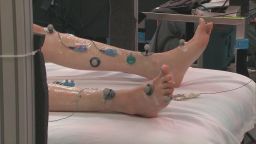Story highlights
Man paralyzed after an accident with a drunken driver gets electrodes wired into his spine
Researchers try different voltages, and after a couple hours, patient is able to move his legs
Other test subjects have got bladder and sexual function back after treatment
Every morning for 2? years, Calven Goza tried to move his legs, hoping against hope and medical science that this time, this day, would be different.
It never was.
An accident with a drunken driver left Goza paralyzed below the chest. No amount of wishful thinking could help him move his legs again.
But on December 5, Goza, 26, got another chance.
This time, researchers wheeled him into a laboratory at the University of Louisville. There, he became one of the first study subjects to receive a new therapy designed to help paralyzed people move their legs again.
Cell transplant allows paralyzed man to walk again

Sensors were wired up and down his leg. Researchers had implanted electrodes in his spine. On his toe was a ring and a string. The goal was for him to pull that string with his toe.
For two hours, the scientists sent jolts of electricity to the receptors surgically implanted in Goza’s spine.
Goza tried mightily to move his legs – even a toe – but nothing happened.
The researchers played with different combinations of voltage, changing currency and polarity.
But still, Goza couldn’t move.
“Do you think you need a little more voltage?” asked Susan Harkema, a neuroscientist and the lead researcher on the project.
“Sure,” Goza answered. “Let’s give it a try.”
Stem cells help nearly blind see
They amped it up, and his toe moved the string. Doctors changed the configuration of the voltage again, and something amazing happened.

Goza bent his knee.
A man who hasn’t been able to move his legs since the accident was now lifting his leg off the table.
The whole room lit up with smiles.
“It was pretty awesome,” Goza said. “I questioned it at first: Maybe it didn’t actually happen, and I was just hoping it did.”
Over the next few hours, Goza lifted his legs several more times.
Science made the impossible possible for Goza.
Goza won’t necessarily walk again, even though his doctors are hopeful. Over the past five years, four other paralyzed men have had this therapy, but none of them can walk. At least not yet.
Still, other paralyzed men have experienced benefits from the therapy that some say may be even more important than walking: Now, they can control their bowels and bladders. They can even have sex.
For paralyzed men, sexual function just as important as walking
“Sure, I’d like to walk someday,” said Kent Stephenson, one of the study subjects. “But just give me sexual function and bowel and bladder control – I’m a happy camper.”
Another study subject’s blood pressure, which had been fluctuating wildly and making him feel weak, came back under control after the therapy.
They will continue to examine the treatment’s impact on the cardiovascular system.
And in 2015, the Louisville researchers plan to test this overall treatment in seven more patients.
